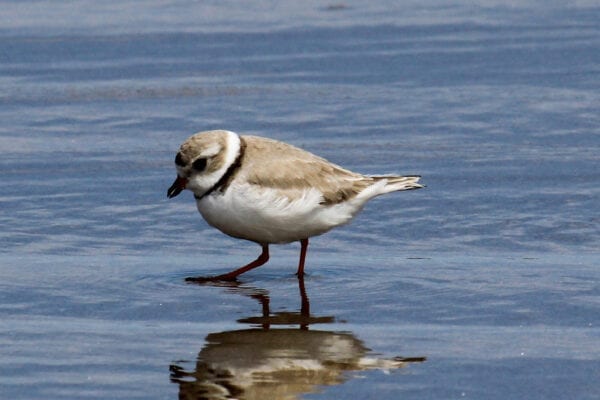
Piping Plover by David Small
Piping Plover
Scientific name: Charadrius melodus
Cool fact: A Piping Plover parent will attempt to lure a potential predator away from its nest by feigning a broken wing.
A small, pale-brown bird that nests on sandy beaches, the Piping Plover, along with its sand-colored eggs and chicks, can be difficult to see. Thus camouflaged, they are especially vulnerable to being unintentionally trampled by beachgoers. And that’s only the beginning of the challenges this small shorebird faces in Maine, where it is an endangered species. Human activity on beaches, including dog-walking, fireworks, beach games, and vehicular traffic, as well as loss of beach nesting habitat to development, have taken a serious toll. And the encroaching development, along with the trash people leave on beaches, have attracted more nest-raiding predators—cats, dogs, raccoons, skunks, and crows—to the neighborhood.
According to Partners In Flight (a bird coalition made up of more than 150 governmental entities and nonprofits) the global population of Piping Plovers totals only 8,400 individual birds. Protecting this species has required special management and oversight. On Maine’s sandy southern beaches, this oversight has been happening for many years thanks to ongoing partnerships between Maine Audubon, Maine Inland Fisheries & Wildlife, the US Fish and Wildlife Service, various municipalities, and landowners, aided by dozens of volunteers. On beaches where the plovers nest—including Ogunquit, Western, Seawall, and Popham Beaches, Reid State Park beach, and elsewhere—nesting areas are fenced off and informational signs erected. On many beaches, volunteers also educate beach visitors in person about the importance of staying away from the birds and their nests.
The conservation efforts to support this endangered bird are slowly paying off. In 2020 the nest-monitoring program tallied 98 pairs in the state and 199 fledged chicks. That might not sound like much, but it was one of the plover’s most successful nesting seasons in the past 25 years. Many beaches in 2020 hosted the largest number of birds in decades.
Maine shorebird conservationist Charles Duncan describes the Piping Plover recovery in Maine, as “a testament to how conservation needs to be done.” Citing a recent experience on a Maine beach, in which a town councilor stopped him to make him aware of the plovers’ presence, he affirms, “The fact that she and so many others take protection of this species so personally is really why we’re seeing this recovery. Success came once local municipalities and land trusts, led by nonprofits like Maine Audubon, got engaged and convinced both locals and tourists that sharing the beach with the plovers was the right thing to do. Attitudes changed for the better and so did behavior.”
Piping Plovers arrive in Maine as early as mid-March, among the first shorebirds to arrive and the first to fly south in late summer. The bird’s ability to blend in on the beach is enhanced by its tendency to forage solo rather than as part of a flock and to stand still more often than other shorebirds. As birder and author Peter Dunne has described, “When it moves, you see it. When it doesn’t, you don’t.” Maine’s other small plover, the Semipalmated, is much darker brown and found more often amid other species.
The Piping Plover’s large, dark eyes set in a pale face give it an expression that Dunne describes as “gentle and serene.” Its short orange bill has a black tip as if dipped in ink; its legs are also orange. Male and female birds look alike. In breeding plumage both sport a dark broken collar and forehead band. The “Piping” of its name refers to its high-pitched, piping calls that can carry far in a sea breeze.
From keeping such a close eye on nesting birds, we’ve learned that plover pairs are monogamous for at least a summer, with both birds sharing nest duties. The nest is simply a shallow indentation in the ground lined with a few small pebbles or shells. Precocial chicks walk around on their own soon after hatching. Fuzzballs on legs best described as “wicked cute,” plover chicks will often crowd for protection under a standing parent, which then looks for all the world like it has six to ten legs. When it senses a threat, a plover chick will freeze in place, a behavior that doesn’t always serve it well around active or curious humans.
Their breeding range includes appropriate habitat in maritime Canada, southern Maine down the Atlantic Coast into the Carolinas, the Great Plains, and a handful of beaches on the Great Lakes. Because so many of the birds are banded, we know that Atlantic coast birds spend the winter along the eastern coasts of Mexico and Central America and on islands in the Caribbean. According to the Cornell Lab of Ornithology, researchers discovered only fairly recently that, not unlike some Mainers, one-third of the Atlantic population of Piping Plovers winters over in the Bahamas.
As if the many threats this vulnerable species faces were not enough, rising sea levels and more frequent coastal storms resulting from global warming may especially impact these wintering areas. New and even more complex partnerships will be needed to continue to keep this vulnerable species from the brink of extinction.
Kristen Lindquist is a birder, naturalist, and poet living in Camden, Maine.









